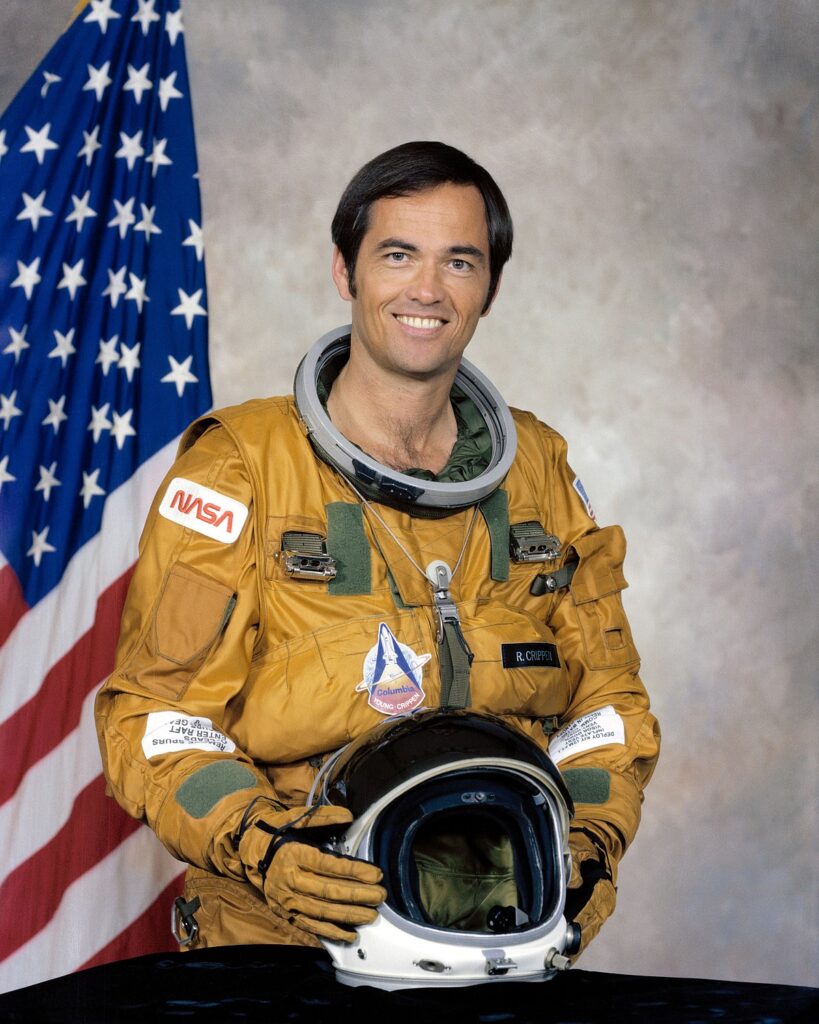Robert L. Crippen was born in Beaumont, Texas, on September 11, 1937. He grew up in Porter, Texas, where his mother, Ruth C. Crippen ran a tavern for 40 years until her death in 1982. He graduated from New Caney High School in Caney, Texas and received a Bachelor of Science degree in Aerospace Engineering from the University of Texas in 1960.
Crippen then received his commission through the Navy’s Aviation Officer Program at Pensacola, Florida. He continued his flight training at Whiting Field, Florida then went to Chase Field in Beeville, Texas, where he received his pilot’s wings. From June 1962 to November 1964, Crippen was assigned to Fleet Squadron VA-72 as an attack pilot aboard the USS Independence. He later attended the US Air Force Aerospace Research Pilot School at Edwards Air Force Base, California, and upon graduation, remained on as an instructor until his selection to the USAF Manned Orbiting Laboratory (MOL) Program in October 1966. MOL was America’s first attempt to build a space station (the program was canceled in 1969). Captain Crippen was among the second group of aerospace research pilots to be assigned to the MOL Program. He has logged more than 6,500 hours flying time, which includes more than 5,500 hours in jet aircraft.
Robert Crippen became a NASA astronaut in September 1969. In 1973 and 1974 he was a member of the astronaut support crew for the Skylab 2, 3, and 4 missions, and served in this same capacity for the Apollo-Soyuz Test Project mission in 1975. He completed his first space mission as Pilot on STS-1, the first orbital test flight of a space shuttle (the Columbia) which launched from Kennedy Space Center (KSC) on April 12, 1981. John Young commanded the 54-hour, 36-orbit engineering test flight, evaluating and verifying Shuttle systems’ performance during launch, on-orbit, and landing operations. Tests included evaluation of Orbiter hardware and software systems, investigation of its thermal response while in orbit, attitude and maneuvering thruster systems and guidance navigation system performance, and evaluation of Orbiter crew compatibility.
Columbia was the first true manned, reusable spacecraft. It was also the first manned vehicle to be flown into orbit without benefit of previous unmanned orbital testing and the first craft with wings to be launched using solid rocket boosters. It was also the first winged reentry vehicle to return to a conventional runway landing. The shuttle landed safely at Edwards Air Force Base, California on April 14, 1981.
Crippen commanded the STS-7 mission, the second flight for the Challenger, launched from KSC on June 18, 1983. This was the first shuttle mission with a five-person crew; one of them was Sally Ride, the first American woman to enter outer space. During the flight the crew deployed satellites for Canada and Indonesia, operated the Canadian-built Remote Manipulator System to perform the first deployment and retrieval exercise with the Shuttle Pallet Satellite, and conducted the first formation flying of the orbiter with a free-flying satellite. Challenger landed safely at Edwards on June 24, 1983.
On his third flight Robert Crippen commanded STS 41-C, launched from KSC on April 6, 1984. During the mission the crew successfully deployed the Long Duration Exposure Facility; retrieved the ailing Solar Maximum Satellite, repaired it onboard the orbiting Challenger, and replaced it in orbit using the robot arm called the Remote Manipulator System; flight tested the Manned Maneuvering Units in two extravehicular activities (EVA’s), and operated the Cinema 360 and IMAX Camera Systems. STS 41-C ended on April 13 with a landing at Edwards.
Robert Crippen was next Spacecraft Commander of STS 41-G Challenger, from October 5 to 13, 1984 (both takeoff and landing were at KSC). The seven-person crew on this mission remains the largest group to ever enter space in one vehicle. During the flight the crew deployed the Earth Radiation Budget Satellite, conducted scientific observations of the earth with the OSTA-3 pallet and Large Format Camera, and demonstrated potential satellite refueling with an EVA and associated hydrazine transfer.
With this fourth flight Robert Crippen logged a total of over 565 hours in space, completing 374 orbits of the Earth and traveling over 9,400,000 million miles.
From 1986 to 1989, Crippen was deputy director of Shuttle Operations for NASA headquarters at Kennedy Space Center. He was responsible for final Shuttle preparation, mission execution, and return of the orbiter to KSC. He then served as director of the Space Shuttle program at NASA Headquarters in Washington, D.C. from 1990 until he was named KSC director in 1992. In 1991 he retired from the Navy with the rank of captain.
In his Washington post, Robert Crippen presided over the overall Shuttle program requirements and performance, and total program control including budget, schedule, and program content. At KSC, he managed the processing, launch, and recovery of Space Shuttle missions until 1995 when he retired from NASA to become vice president of Training Simulation Systems at Lockheed Martin Information Systems. In December 1996, Crippen was named President of the Thiokol Propulsion Group, Brigham City, Utah. He also served as President of the American Institute of Aeronautics and Astronautics in 1999 and 2000. He retired from Thiokol in 1002.
In 2006 Robert Crippen received the Congressional Space Medal of Honor for his role as the first pilot of a space shuttle mission. Captain Crippen has won many other awards, including the NASA Outstanding Leadership Medal (1988); Distinguished Service Medals (1985, 1988, 1993); U.S. Navy Distinguished Flying Cross (1984); Defense Meritorious Service Medal (1984); Federal Aviation Administration’s Award for Distinguished Service (1982), Goddard Memorial Trophy (1982), Harmon Trophy (1982); NASA Space Flight Medals (1981, 1983, and 2 in 1984); NASA Distinguished Service Medal (1981), Department of Defense Distinguished Service Award (1981); American Astronautical Society Flight Achievement Award (1981); National Geographic Society’s Gardiner Greene Hubbard Medal (1981); Aviation Hall of Fame 1981 Al J. Engel Ward; American Legion’s Distinguished Service Medal (1981), Society of Experimental Test Pilots Ivan C. Kincheloe Award (1981); and the NASA Exceptional Service Medal (1972).

